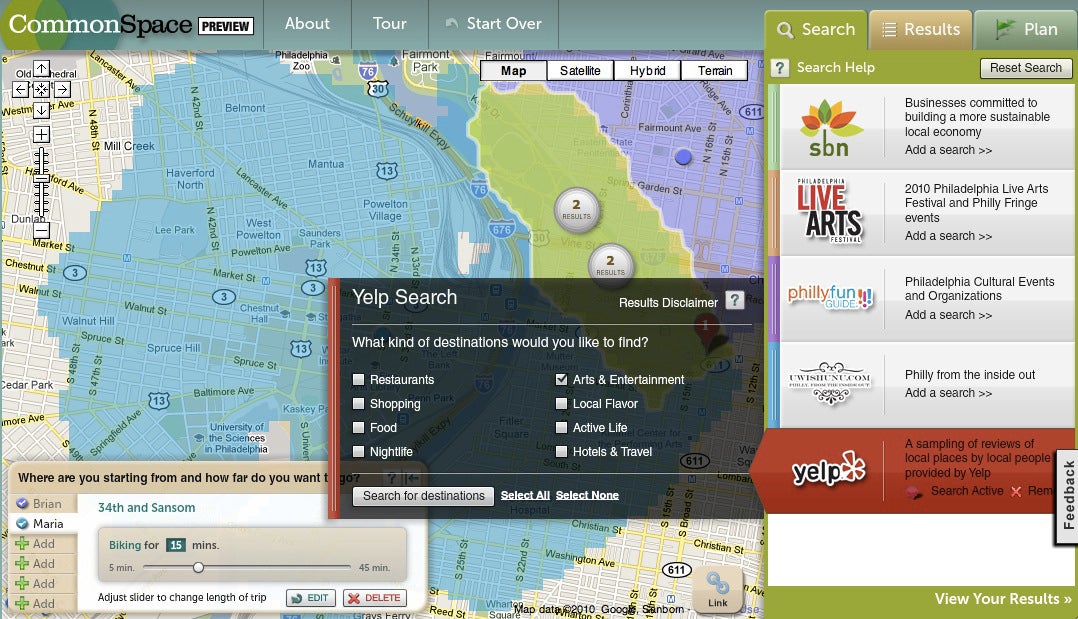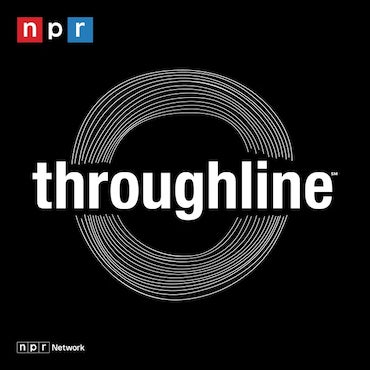New Philly mapping app gives dazzling directions to local businesses

This piece is reported in partnership with Technically Philly, a news site that covers technology in the Philadelphia region.
This afternoon, I made last minute plans to meet a colleague to discuss some pressing business. We both had a packed schedule. I’d be biking from University City. He’d be on foot from 5th and South.
Sure, we could go to a staple favorite in Old City, one that’s convenient for him and I both. But what about trying something new? I usually rely on word of mouth, but I had no new ideas. And as for search engine results—where’s the serependipity?
I decided to try CommonSpace [http://www.commonspace.us] — a web application which soft-launched Friday morning — a joint project between Callowhill-based geographic information system firm Azavea, nonprofit tech consultant NPower, the Sustainable Business Network and a handful of other partners, and funded by the William Penn Foundation. [Full Disclosure: PlanPhilly is funded by the William Penn Foundation through PennPraxis and the University of Pennsylvania School of Design.]
The glossy new mapping tool — which helps Philadelphians find under-the-radar businesses and events —is impressive.
On the site, I entered mine and my colleague’s address, our preferred modes of transportation and the amount of time we were willing to travel. I filtered restaurants that are a part of SBN’s network. And low and behold, a cafe neither of us knew: Essene Market & Cafe, on South 4th Street.
I added the restaurant to an itinerary and emailed it to my colleague so he could see the results. His response? “This is amazing,” he wrote back. [The permalink for those results is here]
The consumer-focused web application is impressive, though organizers say its only a pilot with more features to come.
HOW IT HAPPENED
The William Penn Foundation administered a $180,000 grant to NPower, which managed the project with insight from the Sustainable Business Network. Azavea handled development, including valuable in-kind hours as well, organizers say.
In planning the platform, NPower reached out to nearly a dozen stakeholders for feedback and ideas, including the Philadelphia Commerce Dept., PIDC, Cultural Alliance, Bicycle Coalition, Penn Future, Electronic Inc., Chariot Solutions, and Select Greater Philadelphia.
Always, the Sustainable Business Network — an entity funded in part by the William Penn Foundation — was the “client” of the project. The goal was to help local storefront businesses better connect with consumers.
“We had an eye toward developing a web app that solved an economic development problem while being consumer-friendly,” SBN Executive Director Leanne Kruger-Braneky said.
Additionally, a priority was to focus on SBN’s network in Philadelphia, which makes up half of its 500 regional businesses, all of which focus on sustainable practices. “When I visit a new place, I’m always seeking a truly unique business with local flair. [CommonSpace] is a way to find businesses with Philly flavor,” Kruger-Braneky said.
As the project was developing, management realized the potential to bring on additional partners. Philadelphia Live Arts Festival and Philly Fringe events fit naturally, as the thousands of Fringe events can be cumbersome to find. Greater Philadelphia Tourism Marketing Corporation’s uwishunu arts and entertainment blog, Philly Fun Guide and Yelp were also pulled into the platform for their array of business listings.
Organizers hope to extend to additional content partners as it wraps up its pilot in November. There’s also the possibility for new platform integration, like a mobile application.
And other cities are looking at Philadelphia with envy, said the William Penn Foundation’s Patrick Sherlock, who helped coordinate the project. “When I’ve sent it to people from out of town, they’ve asked, ‘Could I bring this to Charlottesville, Berkeley, New York?’ It’s potentially a nice distinction for Philadelphia.”
For now, the groups are looking for feedback to fix bugs, address concerns, add features, and better manage traffic before a full November launch.
HOW IT WORKS
At first, Azavea had demoed technology that helped businesses find better ways to locate in the Philadelphia region. The firm was able to map businesses and geographically weight factors like demographic composition, household income, and retail traffic and growth. A heat map would then display best-location for an interested business.
But it wasn’t a home run, organizers said. What made more sense — and what had longer-term and wider potential was a consumer-focused approach that could still help businesses find those kinds of opportunities while connecting existing businesses with new customers.
So a team of two to four developers at Azavea, led by project manager Tamara Manik-Perman, began to rethink the process.
“We started from scratch, reusing some existing software frameworks,” she said, which would calculate routes and transit sheds on a map. It showed what restaurants, stores and other businesses were close enough to get to by walking, biking, or utilizing public transportation.
“It was something that fit with the goals of Sustainable Business Network; it emphasized local businesses and underscored the point that what seems to be close to you to in the city isn’t always intuitively accessible.”
The platform is built on OpenStreetMap data — an open source project to map the globe with GIS tools. The map is the foundation of the platform, which also helps directionality calculations (the math expects a bike-riding user will ride the correct way down a one-way street). CommonSpace also pulls in SEPTA’s bus and rail schedules, and Manik-Perman said that there’s an opportunity in the future to include bike networks, elevation data and more.
Using the open source GraphServer framework, which correlates not only routes, but routes and time, too, the CommonSpace engine prompts a user for how much time he or she is willing to travel. Not just how far.
When a user enters an address, it is geocoded onto the map. Then, using transit and route data, tens of thousands of possible routes from that address are graphed behind-the-scenes. The application then calculates the amount of time it takes to get from the origin address outward. Then, using Adobe Flex, a polygon is mapped over Google Maps to show, in real-time, the “transit shed” of a user — the possible area that someone can get to in a certain amount of time using a particular transporation method.
Finally, using that polygon transit shed, the application filters selections from a handful of third-parties – in this case, the Sustainable Business Network, Philadelphia Live Arts Festival, Philly Fun Guide, GPTMC’s uwishunu arts and entertainment blog, and Yelp. Each posed a different challenge for interpolating data, whether it was Yelp’s API, SBN’s Salesforce database or uwishunu’s GeoRSS database.
But for a user, it’s all about ease-of-use.
Using the technology, users can not only map their own transit shed to find local businesses, but they’re able to include up to six friends in on the process, as well.
If there are six friends — each living in a different neighborhood — who want to find a restaurant or retail business they each can walk to, CommonSpace parses their addresses like a Venn diagram, finding only the businesses within the combined group’s transit shed.
Users are able to plan an entire night out with the platform’s itinerary feature. One by one, dining, shopping and event locations can be added or deleted from an interactive itinerary, which can be saved for later use and sent to anyone. Directions can even be mapped and printed so no one gets lost.
And though there’s a few bugs — like when the map clears myseriously with a mouse swipe — there are few gripes with this pilot launch.
“We wanted to build a buzzworthy project that would allow you to experience Philadelphia in a different way,” Sherlock said.
Buzzworthy and different, no doubt.
Contact the reporter at bkirk@planphilly.com
WHYY is your source for fact-based, in-depth journalism and information. As a nonprofit organization, we rely on financial support from readers like you. Please give today.



